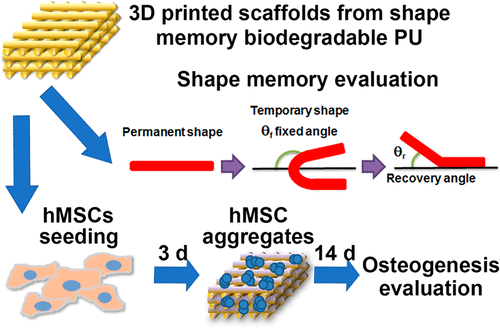当前位置:
X-MOL 学术
›
ACS Biomater. Sci. Eng.
›
论文详情
Our official English website, www.x-mol.net, welcomes your feedback! (Note: you will need to create a separate account there.)
Biodegradable Water-Based Polyurethane Shape Memory Elastomers for Bone Tissue Engineering
ACS Biomaterials Science & Engineering ( IF 5.8 ) Pub Date : 2018-03-07 00:00:00 , DOI: 10.1021/acsbiomaterials.8b00091 Yu-Jen Wang,U-Ser Jeng,Shan-hui Hsu
ACS Biomaterials Science & Engineering ( IF 5.8 ) Pub Date : 2018-03-07 00:00:00 , DOI: 10.1021/acsbiomaterials.8b00091 Yu-Jen Wang,U-Ser Jeng,Shan-hui Hsu

|
Shape memory polymers (SMPs) are polymers with the shape memory effect. The biodegradable SMPs are candidate materials for making biomedical devices and scaffolds for tissue engineering. Superparamagnetic iron oxide nanoparticles (SPIO NPs) have recently been reported to promote the osteogenic induction of human mesenchymal stem cells (hMSCs). In this study, we synthesized water-based biodegradable shape memory polyurethane (PU) as the main component of the 3D printing ink for fabricating bone scaffolds. The 3D printing ink contained 500 ppm of SPIO NPs to promote osteogenic induction and shape fixity, and it also contained polyethylene oxide (PEO) or gelatin for the improvement of printability. Scaffolds were printed by the microextrusion-based low-temperature fuse deposition manufacturing (LFDM) platform. Both PU–PEO and PU–gelatin ink showed excellent printability. Shape memory properties were evaluated in 50 °C air and 37 °C water. PU–PEO scaffolds showed better shape fixity and recovery than PU–gelatin scaffolds, while the shape memory properties in water were better than those in air. hMSCs were seeded for evaluation of bone regeneration. The proliferation of the hMSCs in PU/gelatin and PU/gelatin/SPIO scaffolds was greater than that in PU/PEO and PU/PEO/SPIO scaffolds, confirming the better compatibility of gelatin vs PEO as the viscosity enhancer of the ink. The gradual release of SPIO NPs from the scaffolds promoted the osteogenesis of seeded hMSCs. With SPIO in the scaffolds, the osteogenesis increased 2.7 times for PU/PEO and 1.5 times for PU/gelatin scaffolds based on the collagen content. Meanwhile, SPIO release from PU/PEO/SPIO scaffolds was faster than that from PU/gelatin/SPIO scaffolds at 14 days, consistent with the better osteogenesis observed in PU/PEO/SPIO scaffolds. We concluded that 3D printed PU scaffolds with shape memory properties, biodegradability, and osteogenic effect may be employed to the minimally invasive surgical procedures as customized-bone substitutes for bone tissue engineering.
中文翻译:

可生物降解的水性聚氨酯形状记忆弹性体,用于骨组织工程
形状记忆聚合物(SMP)是具有形状记忆效应的聚合物。可生物降解的SMP是用于制造用于组织工程的生物医学设备和支架的候选材料。最近已经报道了超顺磁性氧化铁纳米粒子(SPIO NPs)促进人间充质干细胞(hMSCs)的成骨诱导。在这项研究中,我们合成了水性生物可降解形状记忆聚氨酯(PU)作为制造骨骼支架的3D打印油墨的主要成分。3D打印油墨包含500 ppm的SPIO NP以促进成骨诱导和形状固定,并且还包含聚环氧乙烷(PEO)或明胶以提高可印刷性。支架是通过基于微挤压的低温熔丝沉积制造(LFDM)平台进行印刷的。PU-PEO和PU-明胶油墨均显示出优异的可印刷性。在50°C的空气和37°C的水中评估形状记忆特性。PU-PEO支架比PU-明胶支架表现出更好的形状固定性和恢复性,而水中的形状记忆性能优于空气中的形状记忆性能。hMSCs播种以评估骨再生。hMSCs在PU /明胶和PU /明胶/ SPIO支架中的增殖大于在PU / PEO和PU / PEO / SPIO支架中的增殖,证实明胶与PEO作为油墨的粘度增强剂具有更好的相容性。SPIO NPs从支架中的逐步释放促进了种子hMSC的成骨作用。在支架中使用SPIO时,基于胶原蛋白含量,PU / PEO的成骨作用增加了2.7倍,PU /明胶支架的成骨作用增加了1.5倍。同时,从PU / PEO / SPIO支架中释放SPIO的速度比在14天时从PU /明胶/ SPIO支架中释放的速度快,这与在PU / PEO / SPIO支架中观察到的更好的成骨性相一致。我们得出的结论是,具有形状记忆特性,可生物降解性和成骨作用的3D打印PU支架可用于微创外科手术,作为骨组织工程的定制骨替代物。
更新日期:2018-03-07
中文翻译:

可生物降解的水性聚氨酯形状记忆弹性体,用于骨组织工程
形状记忆聚合物(SMP)是具有形状记忆效应的聚合物。可生物降解的SMP是用于制造用于组织工程的生物医学设备和支架的候选材料。最近已经报道了超顺磁性氧化铁纳米粒子(SPIO NPs)促进人间充质干细胞(hMSCs)的成骨诱导。在这项研究中,我们合成了水性生物可降解形状记忆聚氨酯(PU)作为制造骨骼支架的3D打印油墨的主要成分。3D打印油墨包含500 ppm的SPIO NP以促进成骨诱导和形状固定,并且还包含聚环氧乙烷(PEO)或明胶以提高可印刷性。支架是通过基于微挤压的低温熔丝沉积制造(LFDM)平台进行印刷的。PU-PEO和PU-明胶油墨均显示出优异的可印刷性。在50°C的空气和37°C的水中评估形状记忆特性。PU-PEO支架比PU-明胶支架表现出更好的形状固定性和恢复性,而水中的形状记忆性能优于空气中的形状记忆性能。hMSCs播种以评估骨再生。hMSCs在PU /明胶和PU /明胶/ SPIO支架中的增殖大于在PU / PEO和PU / PEO / SPIO支架中的增殖,证实明胶与PEO作为油墨的粘度增强剂具有更好的相容性。SPIO NPs从支架中的逐步释放促进了种子hMSC的成骨作用。在支架中使用SPIO时,基于胶原蛋白含量,PU / PEO的成骨作用增加了2.7倍,PU /明胶支架的成骨作用增加了1.5倍。同时,从PU / PEO / SPIO支架中释放SPIO的速度比在14天时从PU /明胶/ SPIO支架中释放的速度快,这与在PU / PEO / SPIO支架中观察到的更好的成骨性相一致。我们得出的结论是,具有形状记忆特性,可生物降解性和成骨作用的3D打印PU支架可用于微创外科手术,作为骨组织工程的定制骨替代物。



























 京公网安备 11010802027423号
京公网安备 11010802027423号